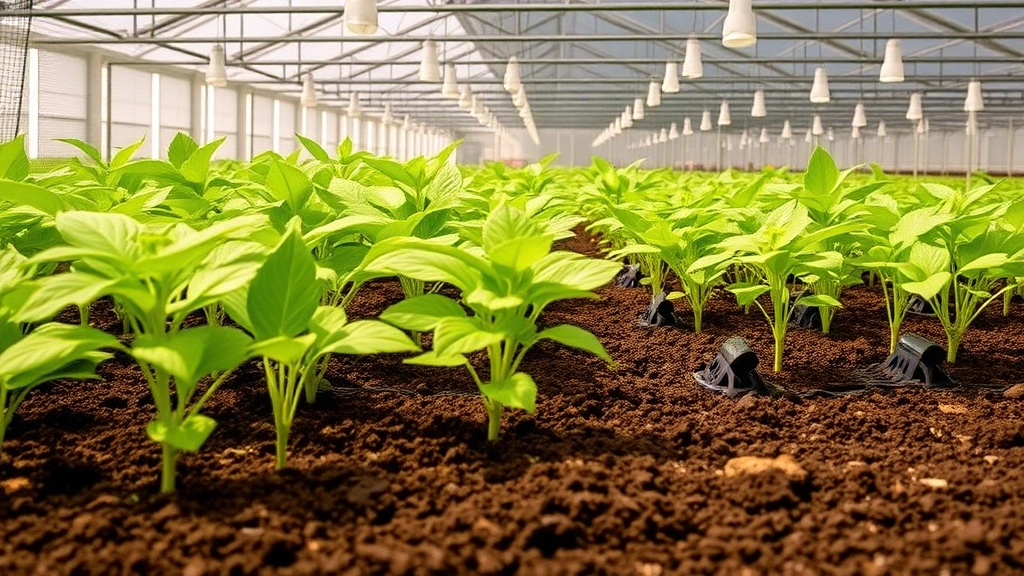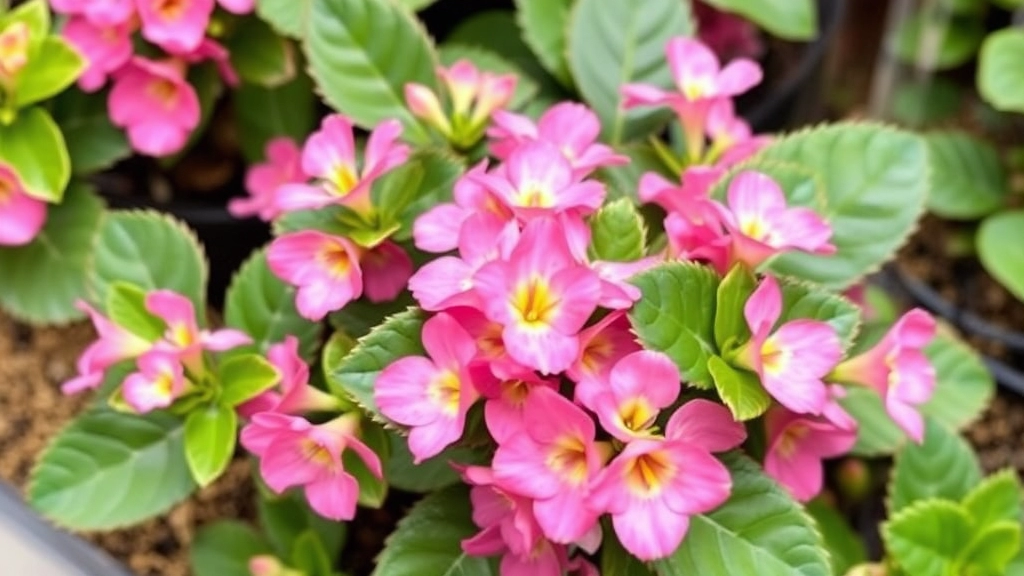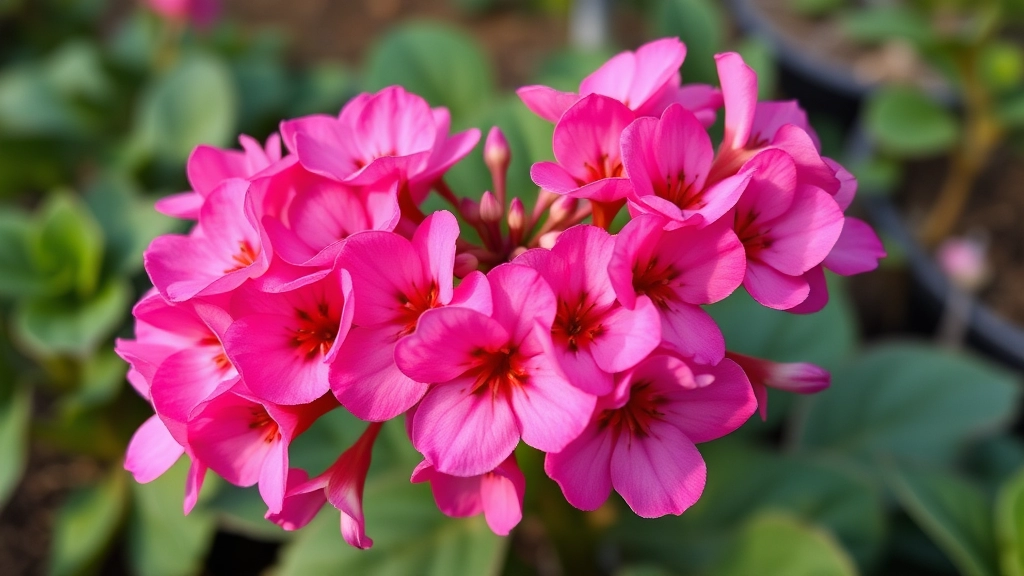Welcome, plant enthusiasts!
Today, we’re diving into the enchanting world of the Kalanchoe ‘Pink Butterflies’, a captivating succulent that’s taking the indoor gardening scene by storm. This unique variety of the Mother of Thousands plant is sure to add a whimsical touch to your green space with its delicate, pink plantlets that resemble fluttering butterflies.
In this article, we’ll explore everything you need to know about caring for these charming succulents. From ideal growing conditions to propagation techniques, we’ve got you covered. Whether you’re a seasoned plant parent or a curious beginner, you’ll find valuable insights to help your Kalanchoe ‘Pink Butterflies’ thrive and become the star of your collection.
Overview of Kalanchoe ‘Pink Butterflies’
Hey there, plant lovers! Let’s chat about the Kalanchoe ‘Pink Butterflies’ – a real showstopper in the succulent world.
Ever wondered why this plant’s got everyone talking? Well, it’s not your average succulent, that’s for sure. Picture this: a plant with leaves that look like they’ve been sprinkled with pink confetti. Sounds pretty cool, right?
Here’s the lowdown on this beauty:
- Origin: It’s a cultivar of Kalanchoe daigremontiana, also known as the Mother of Thousands
- Appearance: Imagine green leaves with pink spots that look like tiny butterflies
- Growth habit: It’s a compact plant, perfect for small spaces
- Lifespan: With proper care, it can thrive for years
But here’s the kicker – those pink ‘butterflies’ aren’t just for show. They’re actually baby plants! Yep, you heard that right. This plant’s got a unique way of reproducing.
Now, you might be thinking, “Sounds great, but is it hard to grow?” Not at all! It’s pretty low-maintenance, making it perfect for both newbies and seasoned plant parents.
So, whether you’re looking to add a pop of colour to your windowsill or searching for a conversation starter, the Kalanchoe ‘Pink Butterflies’ might just be your new best friend.
Remember, though – while it’s stunning, it’s not edible. Keep it away from pets and kids who might fancy a nibble.
Ready to dive deeper into the world of Kalanchoe ‘Pink Butterflies’? Let’s get into the nitty-gritty of how to keep this beauty thriving in your home.
Ideal Growing Conditions

Alright, let’s dive into the ideal growing conditions for Kalanchoe ‘Pink Butterflies’. Here’s the scoop:
Light
- These beauties crave sunshine, but not too much.
- Bright, indirect light is their sweet spot.
- Think of a spot near a window, but not right in the sun’s glare.
Temperature
- They’re not fussy, but they do have preferences.
- Aim for 60-75°F (15-24°C) during the day.
- Night temps can dip a bit, but not below 50°F (10°C).
Humidity
- Here’s where it gets easy – they’re not humidity divas.
- Normal room humidity works just fine.
- No need for fancy humidifiers or misting routines.
Location
- Indoor or outdoor? Both can work.
- Indoors, find a bright spot away from drafts.
- Outdoors, partial shade is key – morning sun, afternoon shade.
- Just remember, they’re not frost-hardy, so bring ’em in when it gets chilly.
Pro tip: Rotate your plant every few weeks for even growth.
Bottom line: Kalanchoe ‘Pink Butterflies’ isn’t too demanding. Give it decent light, comfy temps, and you’re golden. If you’re interested in other Kalanchoe varieties, check out the Kalanchoe tomentosa varieties for some fuzzy-leaved options. And if you’re curious about the spiritual side of Kalanchoe, you might want to explore the spiritual uses of Kalanchoe pinnata.
Soil and Potting Requirements
Alright, let’s dive into the nitty-gritty of soil and potting for our Kalanchoe ‘Pink Butterflies’. Trust me, getting this right is like giving your plant a five-star hotel to live in.
Ever wondered why your Kalanchoe looks a bit meh? It might be throwing a tantrum about its soil. Here’s the lowdown:
What’s the perfect soil mix?
- Well-draining soil is your best mate here. Think cactus or succulent mix.
- If you’re feeling fancy, mix regular potting soil with perlite or coarse sand. It’s like giving your plant a spa day.
- Aim for a 50/50 mix of potting soil and drainage material. Your Kalanchoe will thank you.
Potting tips that’ll make your life easier:
- Choose a pot with drainage holes. No one likes wet feet, especially not your Kalanchoe.
- Terra cotta pots are great. They’re like breathable yoga pants for your plant.
- Don’t go too big – a snug pot is better than a mansion. Your Kalanchoe likes to feel cozy.
Here’s a pro tip: Add a layer of gravel at the bottom of the pot. It’s like giving your plant a fancy water feature, minus the actual water.
Remember, Kalanchoe ‘Pink Butterflies’ isn’t just any old plant. It’s a bit of a diva when it comes to soil. But get it right, and you’ll have a plant that’s happier than a kid in a candy store.
So, next time you’re potting up your Kalanchoe, think about what you’re putting it in. The right soil and pot can make all the difference between a plant that’s just surviving and one that’s thriving. And let’s face it, we all want our plants to be the talk of the town, right?
Watering and Feeding
Alright, let’s talk about keeping your Kalanchoe ‘Pink Butterflies’ happy and hydrated.
Water: The Golden Rule
These succulents are pretty chill when it comes to water. They’re like that friend who’s always up for a drink, but doesn’t need one to have a good time. Here’s the deal:
- Water thoroughly when the soil’s dry to the touch
- Let excess water drain out completely
- Don’t let ’em sit in water – they hate wet feet
Feeding: Less is More
Kalanchoe ‘Pink Butterflies’ aren’t big eaters. Think of them as the minimalists of the plant world. A light feed during growing season (spring and summer) is all they need.
- Use a balanced, water-soluble fertiliser
- Dilute it to half strength
- Feed once a month during growing season
- Skip the feed in autumn and winter
Common Watering Mistakes
I’ve seen folks kill these beauties with kindness. Overwatering is the number one killer of Kalanchoe ‘Pink Butterflies’. Signs you’re overdoing it:
- Yellowing leaves
- Soft, mushy stems
- Fungus gnats hanging around
Remember, these plants are succulents. They’re built for drought, not downpours. When in doubt, it’s better to underwater than overwater. Kalanchoe Mother of Thousands, like ‘Pink Butterflies’, thrive on neglect. So, if you’re forgetful like me, you’re in luck! Just be careful not to overwater, as it can lead to issues similar to those seen in etiolated Kalanchoe blossfeldiana.
Propagation Techniques
Alright, let’s dive into how to make more of these gorgeous ‘Pink Butterflies’ without breaking the bank. Trust me, it’s easier than you might think!
Leaf Propagation: The Go-To Method
Here’s the deal: leaf propagation is your best bet with Kalanchoe ‘Pink Butterflies’. It’s like nature’s way of giving you free plants. Here’s how I do it:
- Snip off a healthy leaf – go for the plump ones
- Let it dry out for a day or two (this helps prevent rot)
- Pop it on some well-draining soil
- Mist occasionally, but don’t drown it
Before you know it, tiny plantlets will sprout from the leaf edges. It’s like magic, I swear!
Stem Cuttings: For the Impatient Gardener
If you’re in a hurry (like I often am), stem cuttings are your friend:
- Cut a 4-inch stem just below a leaf node
- Remove lower leaves
- Stick it in some moist soil
- Keep it warm and slightly humid
Roots should appear in about 2-3 weeks. Easy peasy!
The Plantlet Method: Nature’s Gift
Sometimes, your ‘Pink Butterflies’ will do the work for you:
- Look for baby plants growing on the edges of mature leaves
- When they’re about an inch tall, gently twist them off
- Plant these little guys directly in soil
It’s like your plant is saying, “Here, have some babies on me!”
Pro Tips for Propagation Success
- Use a well-draining potting mix – these guys hate wet feet
- Keep propagations in bright, indirect light
- Be patient – good things come to those who wait (and water appropriately)
Remember, propagation is all about experimentation. Don’t be afraid to try different methods and see what works best for you and your ‘Pink Butterflies’.
So there you have it – propagation techniques that’ll have you swimming in Kalanchoe ‘Pink Butterflies’ before you know it. Give it a go, and watch your plant family grow!
Common Problems and Solutions

Let’s chat about the hiccups you might face with your Kalanchoe ‘Pink Butterflies’.
These beauties can be a bit dramatic, but don’t sweat it. We’ve got solutions.
Overwatering: The Big No-No
Spot yellowing leaves? You might be loving it a bit too much with the watering can.
- Cut back on watering
- Make sure your pot has drainage holes
- Let the soil dry out between waterings
Pest Problems: Uninvited Guests
Noticed some tiny critters? Mealybugs and spider mites love these plants.
- Wipe leaves with a damp cloth
- Use neem oil or insecticidal soap
- Isolate affected plants to prevent spread
Leggy Growth: Reaching for the Stars
Is your plant looking a bit stretched out? It’s probably crying out for more light.
- Move it to a brighter spot
- Prune back leggy stems
- Rotate the plant regularly for even growth
Leaf Drop: The Dramatic Exit
Leaves falling off? Could be stress from temperature changes or drafts.
- Keep it away from cold windows and heating vents
- Maintain a consistent temperature
- Avoid sudden moves to drastically different environments
Brown Leaf Tips: The Crispy Conundrum
Crispy brown tips often mean low humidity or too much fertiliser.
- Mist the plant occasionally
- Use a pebble tray for humidity
- Ease up on the plant food
Remember, most Kalanchoe ‘Pink Butterflies’ problems are easy fixes. Keep an eye out, act fast, and your plant will bounce back in no time. If you’re interested in other Kalanchoe varieties, check out the Kalanchoe tomentosa ‘Dorothy’ for a unique fuzzy-leaved option. For those looking to expand their Kalanchoe collection, the Kalanchoe beharensis ‘Oak Leaf’ is another fascinating species to consider.
Repotting and Maintenance
Alright, let’s chat about keeping your Kalanchoe ‘Pink Butterflies’ happy and thriving. Trust me, it’s not rocket science, but there are a few things you’ll want to keep in mind.
Repotting: When and Why?
Look, your plant’s not gonna stay tiny forever. As it grows, you’ll need to give it more space. Here’s the deal:
- Repot every 1-2 years
- Spring’s the best time to do it
- Choose a pot that’s 1-2 inches bigger than the current one
Signs your plant’s screaming for a bigger home:
- Roots poking out of drainage holes
- Water runs straight through when watering
- Growth’s slowed down
How to Repot Like a Pro
- Grab your new pot and some fresh succulent soil
- Gently remove the plant from its old pot
- Shake off excess soil and check the roots
- Trim any dead or rotting roots (if you spot any)
- Place in the new pot and fill with soil
- Don’t water for a few days to let any root damage heal
Maintenance: Keeping Your ‘Pink Butterflies’ Flying High
Regular TLC goes a long way. Here’s what you need to do:
- Pruning: Snip off dead or yellowing leaves to keep it looking sharp
- Cleaning: Dust those leaves with a soft, damp cloth
- Support: If it gets top-heavy, use small stakes to prop it up
Pro tip: After flowering, cut back the flower stalks to encourage bushier growth.
Dealing with Leggy Growth
If your ‘Pink Butterflies’ starts looking like it’s reaching for the stars, it’s probably not getting enough light. Here’s how to fix it:
- Move it to a brighter spot
- Rotate the pot regularly for even growth
- Prune back leggy stems to promote bushiness
Remember, maintaining your Kalanchoe ‘Pink Butterflies’ isn’t about perfection. It’s about giving it what it needs to thrive. Keep an eye on it, adjust as needed, and you’ll have a stunning plant that’ll be the envy of your plant-loving mates.
Seasonal Care Tips for Kalanchoe ‘Pink Butterflies’

Hey there, plant pals! Let’s chat about keeping your Kalanchoe ‘Pink Butterflies’ happy all year round.
Spring: Wakey-Wakey!
- Time to shake off winter blues
- Gradually increase watering
- Start feeding with a balanced fertiliser
- Watch for new growth and adjust care accordingly
Summer: Soak Up the Sun (But Not Too Much!)
- Move to a spot with bright, indirect light
- Water more frequently, but don’t overdo it
- Keep an eye out for pests â they love the warm weather too!
Autumn: Prep for the Chill
- Reduce watering as growth slows down
- Stop fertilising
- Move plants indoors if you live somewhere chilly
Winter: Cosy Time
- Water sparingly â once every 2-3 weeks might do
- Provide bright light, but protect from cold drafts
- Hold off on fertiliser until spring
Pro Tip: Kalanchoe blossfeldiana loves a bit of drama in temperature. Cooler nights (around 10°C) and warmer days can encourage more vibrant colours and blooms.
Remember, these are just guidelines. Your plant might need tweaks based on your specific environment. Keep an eye on it and adjust as needed. For more detailed advice on caring for different Kalanchoe varieties, check out our guide on florist kalanchoe plant care. Happy growing!
Toxicity Concerns
Hey there, plant lovers! Let’s chat about something crucial when it comes to our leafy friend, Kalanchoe ‘Pink Butterflies’. Is it toxic? Short answer: yep, it is. But don’t panic! Let’s break this down in a way that’s easy to digest.
The Lowdown on Toxicity
Kalanchoe ‘Pink Butterflies’, like its cousins in the Kalanchoe family, contains some not-so-friendly compounds. The main culprit? Bufadienolides. Sounds fancy, right? But it’s just a fancy word for “stuff that can make you or your pets sick if ingested”.
Who’s at Risk?
- Pets: Dogs, cats, and other furry friends
- Kids: Especially curious little ones who might fancy a nibble
- Adults: Less likely, but still possible if you’re into eating random plants (which, let’s be real, you shouldn’t be)
Symptoms to Watch Out For
If someone’s had a taste of this pretty plant, here’s what might happen:
- Nausea
- Vomiting
- Diarrhoea
- In severe cases, heart rhythm problems (rare, but worth mentioning)
Keeping It Safe
Now, I’m not telling you to toss your ‘Pink Butterflies’ out the window. Far from it! Here’s how we can keep everyone safe:
- Out of Reach: Pop it on a high shelf or hanging basket
- Educate: Teach kids and visitors about the no-touch, no-taste rule
- Supervise: Keep an eye on pets when they’re near the plant
What If Someone Eats It?
Don’t freak out, but do act fast:
- Remove any plant bits from their mouth
- Rinse their mouth with water
- Call your doc or vet ASAP
The Bottom Line
Look, Kalanchoe ‘Pink Butterflies’ is a stunner, and with a bit of common sense, it’s totally fine to have around. Just treat it like that fancy vase your gran gave you – look, but don’t touch (or eat).
Remember, knowledge is power. Now you know about the toxicity concerns of Kalanchoe ‘Pink Butterflies’, you can enjoy its beauty safely. Keep it out of reach, keep an eye out, and you’re golden!
Buying Guide
Looking to snag a Kalanchoe ‘Pink Butterflies’? Here’s the lowdown on finding the perfect plant.
Where to Buy
- Garden centres are your best bet for healthy specimens.
- Online nurseries offer convenience, but check reviews first.
- Local plant swaps or gardening groups might have cuttings to share.
What to Look For
- Vibrant, plump leaves without spots or discolouration.
- Compact growth with no leggy stems.
- Plantlets along leaf edges should look fresh and pink.
- No signs of pests or disease.
Red Flags
- Avoid plants with yellowing leaves or mushy stems.
- Steer clear if you spot any creepy crawlies.
- Pass on plants with excessive leaf drop.
Price Range
- Expect to pay £5-£15 for a small plant.
- Larger, mature specimens can fetch up to £30.
Top Tips
- Buy in spring or summer for the best selection.
- Ask about the plant’s history and care at the nursery.
- Check if it comes with care instructions.
- Consider buying a few to create a stunning display.
Remember, a healthy ‘Pink Butterflies’ is worth the hunt. Happy plant shopping!
Frequently Asked Questions about Kalanchoe ‘Pink Butterflies’
1. How often should I water my Kalanchoe ‘Pink Butterflies’?
Water your Kalanchoe ‘Pink Butterflies’ when the top inch of soil feels dry to the touch. This usually means watering once every 1-2 weeks, depending on your climate and the plant’s environment. Remember, it’s better to underwater than overwater these succulents.
2. Can I grow Kalanchoe ‘Pink Butterflies’ outdoors?
Yes, you can grow Kalanchoe ‘Pink Butterflies’ outdoors in USDA zones 10-11. However, they’re not frost-hardy, so if you live in a colder climate, it’s best to keep them as indoor plants or move them indoors during winter.
3. Why aren’t my Kalanchoe ‘Pink Butterflies’ producing pink plantlets?
The pink color of the plantlets is influenced by light exposure. If your plant isn’t getting enough bright, indirect light, the plantlets might appear more green than pink. Try moving your plant to a brighter location, but avoid direct sunlight which can scorch the leaves.
4. Is Kalanchoe ‘Pink Butterflies’ toxic to pets?
Yes, Kalanchoe ‘Pink Butterflies’ is toxic to pets if ingested. It contains bufadienolides, which can cause gastrointestinal upset and, in severe cases, heart rhythm problems. Keep this plant out of reach of pets and children.
5. How do I propagate Kalanchoe ‘Pink Butterflies’?
The easiest way to propagate Kalanchoe ‘Pink Butterflies’ is by using the plantlets that grow along the leaf edges. Once they’re about an inch in size, gently remove them and plant them in well-draining soil. You can also propagate from leaf cuttings.
6. Why are the leaves of my Kalanchoe ‘Pink Butterflies’ turning yellow?
Yellowing leaves often indicate overwatering. Ensure your plant is in well-draining soil and that you’re allowing the soil to dry out between waterings. If the problem persists, check for root rot and consider repotting in fresh, dry soil.
7. How big does Kalanchoe ‘Pink Butterflies’ grow?
Kalanchoe ‘Pink Butterflies’ typically grows to about 12-18 inches (30-45 cm) tall and wide. It’s a compact plant, making it perfect for small spaces or as a tabletop decoration.
8. Does Kalanchoe ‘Pink Butterflies’ flower?
While Kalanchoe ‘Pink Butterflies’ is primarily grown for its unique foliage, it can produce small, tubular flowers. However, flowering is rare and not as showy as the pink plantlets on the leaves.

